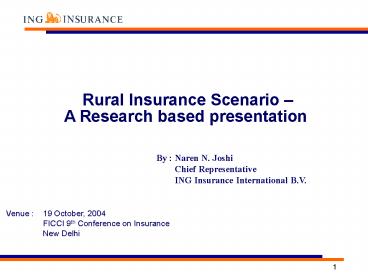Rural Insurance Scenario
1 / 16
Title:
Rural Insurance Scenario
Description:
Rural Insurance Scenario A Research based presentation By : Naren N. Joshi Chief Representative ING Insurance International B.V. Venue : 19 October, 2004 – PowerPoint PPT presentation
Number of Views:127
Avg rating:3.0/5.0
Title: Rural Insurance Scenario
1
Rural Insurance Scenario A Research based
presentation
By Naren N. Joshi Chief
Representative ING Insurance
International B.V.
Venue 19 October, 2004 FICCI 9th
Conference on Insurance New Delhi
2
Rural Insurance Research
- FORTE- A collaboration between FICCI and ING
Insurance, has conducted two research studies to
understand the realities of the rural insurance
market space - Macro Level Study conducted through MART
- Rural Insurance Issues, Challenges
Opportunities - Micro Level Study conducted through James
Martin Co - Developing a Rural Distribution Strategy for
Insurers
3
Macro Study
Objectives of the Research
- Understand rural customers current knowledge,
attitudes and practices regarding savings, loans
and insurance - Identify existing factors, if any, prohibiting
the purchase of insurance policies - Profile potential rural customer segments in
terms of attitudes, behavior and demographics - Develop a broad, cost effective distribution
strategy
4
Macro Study
Key Findings of the Research
- Rural sector offers a huge business opportunity
for insurance companies - Savings ratio is a healthy 30 of income across
all socio economic segments - Awareness about Life Insurance is near universal
- 27 of CWEs already have a life policy
- 51 of all respondents have expressed intention
to purchase a life policy - There are a total of 124 million rural households
- Nearly 20 of all farmers in rural India own a
Kissan Credit Cards. The 23 million credit cards
issued till date offer a huge data base and
opportunity for insurance.
5
Macro Study
Key Findings of the Research (contd.)
- Delivery infrastructure in the form of District
Cooperative Banks, Cooperative Societies, NGOs
and Self Help Groups already exists in most
villages. - Rural connectivity through IT.
- E-choupal of ITC and other similar initiatives
are available as additional delivery channels of
insurance - An extensive rural agent network for sale of Life
insurance products exists - The agent plays a major role in creating
awareness, motivating purchase and rendering
other insurance services
6
Macro Study
Key Findings of the Research (contd.)
- 78 of respondents prefer various combinations
of life insurance like life accident, life
loan, life health accident. - Flexibility in Premium payments is important.
- Security of income and bulk returns, especially
for daughters marriage and childrens education
are major persuasions for taking life policy. - While individuals are undecided about purchasing
insurance from private players, members of
different groups are favorably disposed to
purchasing group insurance through a private
player vetted by the group Herd mentalitySafety
in numbers.
7
Macro Study
Complementary Delivery Systems
Name of the institution/ instrument Accessibility/ coverage of each branch Rural presence/ penetration
Regional Rural Bank 15-20 villages 5000 pop size village
Commercial bank (Rural Branch) 5000 account holders spread over (35-40 villages) 5000 pop size village
Post office 5-6 villages 2000 pop size village
Cooperative society 10,000 members spread over 20-25 villages 5000 pop size village
ITC E choupal 5 to 7 villages Prosperous village
District cooperative bank 7500 accounts Block head quarter
Kissan Credit Card 12 of total no. of farmers in rural area Farmer of any village
E-choupals manned by a Sanchalak provided
with computer and internet connectivity for
procurement of agri produce and giving
information on variety of services to villagers.
8
Micro Research Study
9
Micro Study
Study Phase
- Develop a comprehensive description of available
channels and their delivery capabilities in the
context of rural insurance potentials - Identify and understand the concerns of insurers
and their strategies for facing the challenges
that rural market presents - Develop an Evaluation Framework as a basis for
selection, design and operationalisation of
distribution channels - Primary research in the Muzaffarnagar District of
UP for the feasibility of each available channel
applying evaluation criteria - Develop an activity based cost model to
profitably operationalise the feasible channels
10
Micro Study
District Muzaffarnagar - Span of a Block
District
Per Block
Tehsils
Blocks
8
Panchayats
74
Villages
11
Micro Study
Distribution Channels
Available Channels
Evaluation Criteria
Feasible Channels
Reach
Influence on target segment
Trust reliability
Business acquisition capability
Support requirements
Financial transaction handling
Operational discipline
E-Bima
Customer servicing
New Channel
12
Micro Study
Suggested Strategy Model
DISTRICT COORDINATOR (1)
Insurers Resources
BLOCK COORDINATOR (14)
Coop Bank
Panchayats
Cooperatives
Agents
E-Bima
3
8
5
20
1
No of Channel Units per Block
Av. No. of Agents per LIC Dev Officer 37
13
Micro Study
E-BIMA
- Infrastructure
- A Van
- A Simputer with a Printer
- Video-Audio Facility
- Human Resources
- One Driver
- Two sales cum administrative staff / agent
- Site and Mode of Operation
- Moves Village to Village
- Parks at Panchayat, Local School , Village
Chaupal - Visits 2 Villages and one haat a day
- Works 8 Hours a day
14
Micro Study
Role and Benefits of E-BIMA
- Role
- Awareness Programmes
- Relationship Building and Management
- Business Acquisition
- Policy Servicing and Business Retention through
Premium Collection facilities - Other Benefits
- Support to other Channels for Policy Servicing,
Premium Collection, Policy Query Handling,
Complaint Handling, Assistance in Claim
Processing - Overcome limitations of channels
15
Take Away
- The rural market offers tremendous growth
opportunities for insurance companies but their
success will depend upon their ability to - Develop viable and cost effective distribution
channels and - Build consumer awareness and confidence
- ING is one of the few private insurance companies
highly committed to the rural insurance market in
India . In fact, ING is currently running a pilot
project in rural India.
16
THANKS































